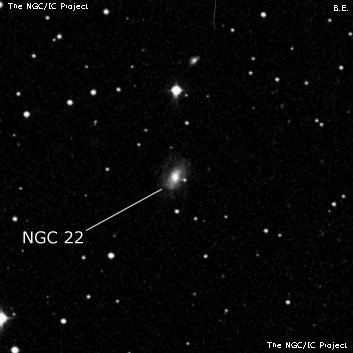
Édouard Stephan discovered NGC 22 = St XIII-1 on 2 Oct 1883 with the 31" reflector at the Marseille Observatory and described "eF; pS; R; lbM, resolvable". His position matches UGC 86 = PGC 690 and he is credited with the discovery in the NGC.
William Herschel possibly discovered this galaxy on 8 Sep 1784 (H IV-15, sweep 260) and recorded "F, S, Stellar, or rather like a faint star with a small chevelure and two burs." His position is poor -- 40 sec too far east and 7' too far south -- but the description is a reasonable fit. Dreyer assumed the observation referred to NGC 16, which is 1 min 25 sec of RA to the west and he commented in the NGC notes "Some error in recording the transit, probably simply of 1 min; reductions correct." Wolfgang Steinicke feels H IV-15 refers to NGC 22 and WH never observed brighter NGC 16 but Corwin and Seligman favor Dreyer's interpretation.
300/350mm - 13.1" (8/24/84): very faint, fairly small, roundish, very diffuse, even surface brightness.
13.1" (11/5/83): extremely faint, small, round. A mag 9 star 3' N interferes with viewing. Located 12' NE of NGC 16.
400/500mm - 17.5" (11/14/87): faint, fairly small, diffuse, slightly elongated, broad concentration. Located 2.5' S of a mag 10 star. Forms a wide pair with NGC 16 12' SW.
Notes by Steve Gottlieb